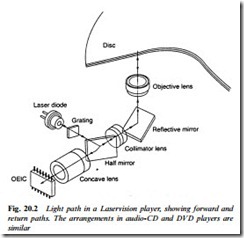LIGHT PATH
The Laservision disc does not have a turntable as such – it is clamped at its centre and scanned from below. Fig. 20.2 shows the light path of one type of pick-up which is suitable for both CD-audio and Laser- vision (CLD) players. The laser diode emits a narrow beam of infra- red light whose wavelength is 780 nm. The first component encountered by the light beam is a grating, a glass plate with horizontal lines etched into it. Here the light beam is split into three by a process of diffraction: a bright central one and two secondary beams of lesser intensity. The three closely spaced beams are now
turned through 90° in a half-mirror, which has the characteristic of reflecting half the light presented to it and admitting half of it, the latter property being used for the reflected beam as we shall see. Next on the light path comes a collimator lens whose job is to capture the diverging light beams and set them on a parallel path towards the reflective mirror which turns the beams through 90° to direct them to the objective lens. This precision component focuses the three light beams to sharp pin-points of light on the surface of the video disc. The diameter of the focused central spot is less than 1 micron, which is comparable with the wavelength (0.78 micron) of the lightwaves themselves. The outer light spots are used for tracking purposes, and the central one to read out the information on the disc surface.
After reflection at the disc the light (now modulated) follows the same path in the reverse direction as far as the half-mirror, through which it passes – with some loss – to a concave lens. Here its coma distortion is corrected, and it is focused onto the surface of the OEIC (Optical Electronics Integrated Circuit), incorporating a matrix of photodiodes whose outputs provide not only the video and audio signals, but also positional feedback to maintain correct beam focus and tracking during initialisation and play. The operation of the beam focusing servo will now be examined.
